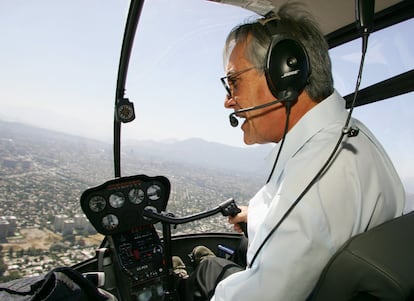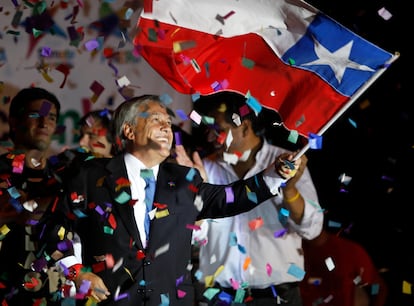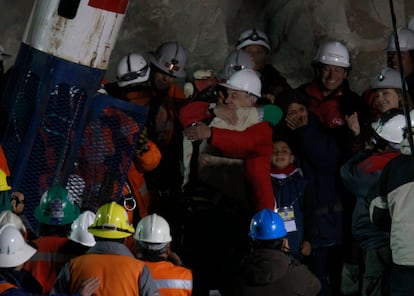Sebastián Piñera: The millionaire politician who liked to gamble and win
Twice president, he broke the hegemony of the Chilean left in 2010, faced a social uprising, and at 74 had not abandoned the possibility of running for office again
Sebastián Piñera, who died on Tuesday when the helicopter he was piloting crashed in Ranco, an area located some 570 miles south of Santiago, was twice president of Chile. He was a democratic president, as was recalled by the Minister of the Interior, Carolina Tohá, when confirming the news. Tohá highlighted the way in which Piñera had dedicated his life to public service. He was an indefatigable politician, a risk-taker who liked to gamble and win. In some of his early electoral campaigns he used the slogan of the locomotive and that image largely represented him both in his life as a politician — he was a member of parliament, president of his party, Renovación Nacional, and then president of the Republic — and in business.
Sebastián Piñera Echenique, 74, was a man whose mind was focused on big things, not subtleties. When he found a shirt he liked in a store, he would buy a dozen of the same design. Ties were usually given to him as gifts. Until arriving at the La Moneda presidential palace for the first time in 2010, he did not have his suits made to measure: they were almost always too long and too wide. His peculiar style — informal, careless, avaricious, austere — showed a character who was much less attentive to the daily routine - such as his wardrobe - than his two great passions: politics and business. But he also had a hobby: flying. In Ranco, where he had a vacation home in a the picturesque Bahía Boique, people could tell when Piñera was flying over the cool waters of the lake, because were familiar with his helicopter.

Married since 1973 to Cecilia Morel — with whom he has four children — Piñera combined politics with his businesses for many years. At the end of the seventies, he obtained representation rights in Chile for Visa and MasterCard, and since then, his subsequent ventures grew in ambition and success. He was the main shareholder of the airline Lan Chile (now Latam), the television channel Chilevisión and Blanco y Negro, the company that manages one of the most popular soccer clubs in the country, Colo-Colo. But this crossover between money and politics was not gratuitous for Piñera: both his ability to make money and to use loopholes to his advantage were his main Achilles heel in his political life.
Piñera was a wealthy man: Forbes estimated his worth at around $2.9 billion, the fifth-largest in the country, according to the 2023 ranking. But he was a first-generation millionaire. Born in Santiago de Chile in 1949, he is the third of the six children born to Magdalena Echenique and José Piñera Carvallo, an engineer and diplomat who was the founder of the Chilean Christian Democracy, the party that for decades represented the country’s middle class. The reasons why the former president did not join his father’s party and ended up joining the right have never been entirely clear. What is certain is that Piñera tried without much success to captivate that moderate center in which he sometimes seemed to feel more at ease than in his own.
He was never a traditional Chilean right-winger, historically more conservative, so among his own ranks there were those who looked at him with certain distrust. Under his administration — as recognized Tuesday by the Homosexual Integration and Liberation Movement (Movilh) — the Gender Identity Law and the Equal Marriage Law were approved, while his government also sent to Congress the Civil Union Agreement for persons of the same sex, AUC, which later became law. He was an average Catholic. He felt at ease visiting former president Barack Obama in Washington, as he did in September 2017, or when he boasting about his close relationships with Nicolas Sarkozy or David Cameron.

Rise in the opposition
In the 1988 plebiscite that sealed the departure of dictator Augusto Pinochet, unlike the rest of the right wing, Piñera voted no to the continuity of the military government. In democracy, he was a senator between 1990 and 1998. During the transition, with the center-left Concertación in power, he rose to become one of the main opposition figures. In 2005 he ran for the presidency, losing to Michelle Bachelet. In 2009, on his second attempt, he achieved a historic triumph: defeating former president Eduardo Frei Ruiz-Tagle, he became the first right-wing president since the return to democracy in 1990 and the first conservative to occupy La Moneda since Jorge Alessandri in 1958, breaking the hegemony of the left in Chile.
He led a government that, in a way, followed the path of the four center-left administrations that preceded him. He did not make a turn to the right — as his own sector would have liked — and his mandate was marked above all by an emphasis on management. After the south-central part of the country was practically destroyed by the 8.8 magnitude earthquake of February 2010, Piñera had to focus on rebuilding.

The government tried — with a certain arrogance — to turn the rescue of the 33 miners who spent 69 days trapped 700 meters underground into a symbol and a vindication of its mantra that by applying a business logic, things could be managed well. The student revolution of 2011, however, put Piñera and his people to the test politically. He had a reputation for being a smart ass and a certain taste for thumbing his nose at protocol, as when he sat at Obama’s desk in the White House to have his picture taken. Or when, during the 2019 protests, he took a selfie at the epicenter of the protests, taking advantage of the curfew. Graduating from Harvard with a PhD and Master’s in economics, Piñera’s forte was not necessarily the softer attributes, such as sympathy or kinship with citizens.
He was impulsive, uncontrollable — even for his advisors and inner circle — but prepared and experienced, as his adversaries acknowledged.
In 2017 he was elected again, defeating a weakened center-left without strong leadership. For the second time, Michelle Bachelet, a socialist, who on Tuesday expressed her condolences, handed him the presidential sash. Between them, they governed for 16 years.

But that second administration was extremely complex. In October 2019 he had to handle the social uprising. The protests were born of accumulated demands and unrest, but it was Piñera who was in La Moneda and both he and his government were a target of the anger. In days when violence in the streets endangered Chilean democracy, the leftist opposition sought to remove him from power through a constitutional impeachment in Congress, accusing him of human rights violations. However, it was not Pinochet who was in charge but, as Tohá recalled on Tuesday, a democratic president. He never abandoned his commitment to democracy and even his harshest critics during that time recognize that today.
Only the pandemic managed to calmed tension in the streets and Piñera has been praised for his management of the health emergency. His entrepreneurial talent allowed him to negotiate with the laboratories to secure vaccines before anyone else in Latin America. In the worst months of the crisis, Chile was the envy of the region for the massive inoculations program it rolled out to the population.
But, as was to be expected, in March 2022 he handed over the presidency to the leftist Gabriel Boric, with whom he always had a strained relationship. However, Piñera did not hesitate to join the activities organized by La Moneda to mark the 50th anniversary of the coup d’état last September: he was not rancorous and knew how to take advantage of opportunities.
Less than two years after leaving La Moneda, he had not completely abandoned the idea of returning to government. His popularity was rising week by week and Piñera was aware that the right wing has a good chance of regaining power in 2026. On Tuesday, when speaking about his predecessor, Boric said that he will receive a state funeral and called for three days of national mourning, acknowledging Piñera as someone who " contributed, from his vision, to building great agreements for the good of the country” and “was a democrat from the very beginning.”
Sign up for our weekly newsletter to get more English-language news coverage from EL PAÍS USA Edition
Tu suscripción se está usando en otro dispositivo
¿Quieres añadir otro usuario a tu suscripción?
Si continúas leyendo en este dispositivo, no se podrá leer en el otro.
FlechaTu suscripción se está usando en otro dispositivo y solo puedes acceder a EL PAÍS desde un dispositivo a la vez.
Si quieres compartir tu cuenta, cambia tu suscripción a la modalidad Premium, así podrás añadir otro usuario. Cada uno accederá con su propia cuenta de email, lo que os permitirá personalizar vuestra experiencia en EL PAÍS.
¿Tienes una suscripción de empresa? Accede aquí para contratar más cuentas.
En el caso de no saber quién está usando tu cuenta, te recomendamos cambiar tu contraseña aquí.
Si decides continuar compartiendo tu cuenta, este mensaje se mostrará en tu dispositivo y en el de la otra persona que está usando tu cuenta de forma indefinida, afectando a tu experiencia de lectura. Puedes consultar aquí los términos y condiciones de la suscripción digital.
More information
Archived In
Últimas noticias
Most viewed
- Oona Chaplin: ‘I told James Cameron that I was living in a treehouse and starting a permaculture project with a friend’
- Reinhard Genzel, Nobel laureate in physics: ‘One-minute videos will never give you the truth’
- Sinaloa Cartel war is taking its toll on Los Chapitos
- Why the price of coffee has skyrocketed: from Brazilian plantations to specialty coffee houses
- Silver prices are going crazy: This is what’s fueling the rally










































